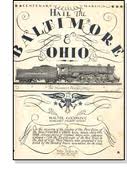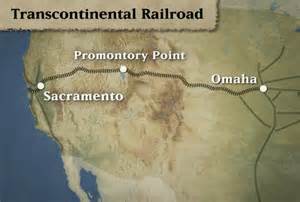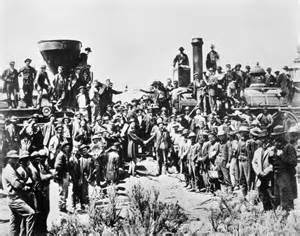The Transcontinental Railroad was a dream come true for many businesspeople and politicians in America, providing a link for goods and communication from the East Coast to the West Coast. The Golden Spike was struck in 1869, but planning for the coast-to-coast route began much earlier. The exploration of the Louisiana Territory by Meriwether Lewis and William Clark had included a journey to the Pacific Coast. Not long after, a chance find of gold in California ushered in the Gold Rush. The American victory in the Mexican-American War had brought a large amount of new territory into the Union. Settlers ventured west, in search of fortune and new homesteads, traveling on the Oregon Trail, Santa Fe Trail, California Trail, and many other routes. 
The advent of the railroad made possible a nationwide network of railroads, along the lines of the East Coast-to-Midwest network of canals that had sprung up in the early part of the 19th Century. The first railroad, the Baltimore & Ohio, made a name for itself by building on the success of the Tom Thumb and illustrating that a rail network was possible. Other rail networks sprung up across the country. The main problem with joining up existing rail networks, though, was that not all tracks were the same. More precisely, many tracks used many different size tracks. It was not easy getting goods from one place to another if the transport had to include different rail networks. The goal of a nationwide rail network was a special project for President Abraham Lincoln, elected in 1860 on the eve of the Civil War. California had become a state in 1850, and many in the North wanted to cement California's place in the Union by building a railroad to the Golden State. The inclusion in that rail line of other territories acquired in the Treaty of Guadalupe Hidalgo would potentially solidify control of those territories as well. The same year that Lincoln was elected, the Pony Express began. Although it lasted a short time, the Pony Express proved that a transportation network from the Midwest to the West Coast was possible. Once talk of building a nationwide rail network grew serious, organizers began to lay plans for the route. Secretary of War Jefferson Davis oversaw the Pacific Railroad Surveys, a number of explorations by scientists and surveyors in search of possible routes, encompassing about 400,000 square miles in all. One of the main surveys was done by Theodore Judah, a chief engineer for the Sacramento Valley Railroad, the first railroad west of the Mississippi River. Judah submitted a 13,000-word proposal for a Pacific railroad to members of Congress and the Cabinet, and he received the funding to conduct a survey to find a suitable route through the rugged Sierra Nevada Mountains.
Another champion of the central route was Asa Whitney, a cousin of Eli Whitney, the inventor of the cotton gin. Whitney, who traveled far and wide at his own expense to promote the central route, proposed that finances could be shared by settlers buying land along the route. On June 20, 1862, the Senate approved a House of Representatives bill passed on May 6, authorizing funding for the Transcontinental Railroad. President Abraham Lincoln signed the bill into law, and contracts were awarded to two companies, Central Pacific and Union Pacific. The law wasn't exactly designed to protect the U.S. Treasury, as government officials discovered when the railroad companies took advantage of the rather generous terms that guaranteed payment of $16,000 a mile for flat land, $32,000 a mile for the high plains, and $48,000 a mile for mountainous terrain. Payment was made by the mile, and the two rail companies went out of their way (literally) to tack on extraneous miles to the route. (This led eventually to the bankruptcy of Union Pacific, mainly because of the efforts of the company's vice president, Thomas Durant, and to the Credit Mobilier scandal.) Central Pacific was run by four directors: James Bailey, a jeweler; Charles Crocker, a seller of dry goods; Mark Hopkins, a hardware merchant and business partner of Asa Whitney; and Leland Stanford, a grocer. Each of these men posted $1,500 to create the company. Sacramento was chosen as the western terminus, and Central Pacific was tasked with building track east from Sacramento. After much discussion, Lincoln himself selected the eastern terminus to be Council Bluffs, Iowa, and Union Pacific began laying track westward from there. 
Central Pacific began its efforts on January 8, 1863, with Leland Stanford, who by then had been elected governor of California, attending the ceremony. To facilitate the building beginning on the West Coast, Central Pacific had shipped many parts from the East Coast, aboard ships. Some engines and cars had to be dismantled for boat transport and then reassembled in the Sacramento shipyards. Because of a few difficulties, including funding and (most prominently) the Civil War, Union Pacific started two years later, in July of 1865. Both railroads used the same gauge (distance between the wheels), 4 feet, 8.5 inches. Tracks were laid to accommodate that gauge. Survey teams set out to find the most suitable routes, indicating which waterways would have to be crossed, which hills would have to be cut, and which mountains would require tunnels to get through. Engineers provided advice on how to make the most of the terrain and the available technology. Laying track was not the easiest job in the world, and thousands of Americans, Chinese, and Irish workers labored to build the railroad. Workers had to dig the rail bed, then lay in wood and the rails and surrounding materials. Workers had to blast tunnels through the mountains, eventually using dynamite, invented by Alfred Nobel in 1867. Central Pacific built 15 tunnels on its route, the longest 1659 feet in length. Construction was especially slow going in the mountains. The route wound through a low pass, but the route still went through the Sierra Nevada Mountains. To keep work going through the winter, workers built dozens of miles of huge wooden show sheds to cover the tracks; as a result, avalanches and snow drifts blew over the wooden "rooves" and didn't cover the tracks or the workers laying them down underneath. Laying track across flatter ground was less time-consuming. One Central Pacific crew laid 10 miles of track in one day. Many other jobs were required as well. Cooks were needed to prepare food for the laborers, who also needed somewhere to live and acquire provisions. Blacksmiths were needed, as were carpenters and clothing manufacturers and repairers. Also necessary were medical teams: accidents were not uncommon. One prime obstacle to the building of the Transcontinental Railroad was the wildlife living on the Great Plains. Cows and bison were two of the prime animal constraints, so much so that early train engines were fitted with a pointed wedge of iron bars called a "cow catcher," which helped move a cow (or a bison or any other kind of large animal) off the tracks without causing harm. Rail crews found resistance from Native Americans, as well. In the same way that the Westward Movement disrupted Native American tribes and lands, the building of the Transcontinental Railroad solidified the European settlers' growing sway over the Great Plains. Frustrated Native Americans robbed rail crews of their livestock, time and again. Raids on rail-building crews were not uncommon. More frequent were raids on surveyors, who went out in advance of the track-laying crews and were more vulnerable as a result. In 1867, a Cheyenne tribe sabotaged part of the rail line, resulting in the deaths of several workers aboard a handcar. A year later, Sioux raiders dismantled rail lines, resulting in a derailment and several deaths. Not all Native American tribes were hostile to the coming of the railroad, however. Pawnee welcomed the railroad (not the least because they wanted support against their enemy the Sioux). Relations between members of the Pawnee tribe and Union Pacific crews were so good that the Native Americans provided a security patrol as the rail line was built through Sioux land.
Later that year, workers completed the final leg to the West coast, with tracks leading from Sacramento to Oakland. The Transcontinental Railroad proved quite popular, after its initial coast-to-coast run that arrived on June 4, 1876, completing a journey from New York City to San Francisco in 83 hours, 39 minutes. By contrast, a stagecoach journey from Missouri, in the middle of the country, to the West Coast could take a month. |
|
Social Studies for Kids
copyright 2002–2024
David White



 Lewis & Clark had reached the West Coast by going through Montana and Oregon. Their route, rail organizers thought, would be too prone to snow in the winter. A more central route was sought. (Proponents of a southern route found their arguments overtaken by events, as the secession of the Southern States eliminated the southern route as a possibility, even though the Gadsden Purchase had made possible such a route.) One thing that the Pony Express also proved was that the central route, utilizing lower passes through the western mountains, could be used for railroads because the snow wasn't prohibitive. Horses could go up steeper grades than railroad engines, though.
Lewis & Clark had reached the West Coast by going through Montana and Oregon. Their route, rail organizers thought, would be too prone to snow in the winter. A more central route was sought. (Proponents of a southern route found their arguments overtaken by events, as the secession of the Southern States eliminated the southern route as a possibility, even though the Gadsden Purchase had made possible such a route.) One thing that the Pony Express also proved was that the central route, utilizing lower passes through the western mountains, could be used for railroads because the snow wasn't prohibitive. Horses could go up steeper grades than railroad engines, though. The two railroads met at Promontory Summit, in Utah, on May 10, 1869, and drove in the Golden Spike, symbolizing the completion of the biggest step in a coast-to-coast railway. Along the way, Central Pacific had laid 690 miles of track and Union Pacific had laid 1,087 miles of track.
The two railroads met at Promontory Summit, in Utah, on May 10, 1869, and drove in the Golden Spike, symbolizing the completion of the biggest step in a coast-to-coast railway. Along the way, Central Pacific had laid 690 miles of track and Union Pacific had laid 1,087 miles of track.
